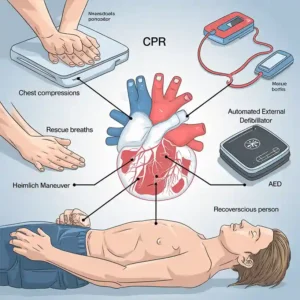Emergencies happen when you least expect them. Knowing how to perform CPR and other life-saving techniques can make the difference between life and death. Here’s a comprehensive guide to help you act quickly and effectively in a critical situation.
Thank you for reading this post, don't forget to subscribe!
Understanding CPR (Cardiopulmonary Resuscitation)
CPR is a life-saving procedure used when a person’s breathing or heartbeat has stopped. This can happen due to drowning, heart attack, or sudden cardiac arrest. The goal of CPR is to keep blood and oxygen circulating to prevent brain damage and increase survival chances.


When to Perform CPR
CPR is necessary when:
- The person is unresponsive and not breathing or breathing abnormally.
- The person has no pulse.
- The person collapses suddenly due to a known heart condition.
How to Perform CPR
Follow these steps to provide effective CPR:
Step 1: Check for Responsiveness
- Tap the person’s shoulder and shout loudly, “Are you okay?”
- If there is no response, call emergency services immediately.
Step 2: Position the Person
- Lay them flat on their back on a firm surface.
- Kneel beside them at chest level.
Step 3: Open the Airway
- Tilt the head back slightly and lift the chin to open the airway.
- Check for breathing for no more than 10 seconds. If the person is not breathing normally, proceed to CPR.
Step 4: Start Chest Compressions
- Place the heel of one hand in the center of the chest.
- Put your other hand on top, interlacing your fingers.
- Push hard and fast, aiming for 100-120 compressions per minute.
- Compress the chest at least 2 inches deep.
- Allow full chest recoil between compressions.
Step 5: Provide Rescue Breaths (if trained)
- Pinch the nose shut and create a seal over their mouth with yours.
- Give two breaths, each lasting one second, ensuring the chest rises.
- If the chest does not rise, reposition the head and try again.
Step 6: Continue CPR
- Keep performing compressions and breaths at a 30:2 ratio.
- Do not stop until emergency responders arrive or the person starts breathing.
Using an Automated External Defibrillator (AED)
An AED is a portable device that delivers an electric shock to restore normal heart rhythm. If available, use it as soon as possible.
How to Use an AED
- Turn it On – Follow the voice instructions.
- Attach the Pads – Place one pad on the upper right chest and the other on the lower left side.
- Analyze Heart Rhythm – The AED will assess if a shock is needed.
- Deliver a Shock – Ensure no one is touching the person, then press the shock button.
- Resume CPR – Continue chest compressions until help arrives.
Choking First Aid
A blocked airway can be fatal. If someone is choking, act quickly.
For Adults and Children Over 1 Year
- Encourage the person to cough if they can still breathe.
- Perform the Heimlich maneuver:
- Stand behind them.
- Wrap your arms around their waist.
- Make a fist and place it just above the navel.
- Thrust inward and upward until the object is expelled.
For Infants (Under 1 Year)
- Lay the baby face-down along your forearm.
- Give five firm back slaps between the shoulder blades.
- If needed, turn the baby over and give five chest thrusts.
The Recovery Position
If a person is unconscious but breathing, place them in the recovery position:
- Lay them on their side.
- Bend the top knee for support.
- Tilt the head slightly to keep the airway open.
- Monitor their condition until help arrives.
Drowning First Aid
If someone is drowning:
- Remove them from the water if it is safe to do so.
- Check for breathing and pulse.
- Start CPR immediately if they are unresponsive.
- Continue until emergency responders take over.
Recognizing and Responding to a Heart Attack
A heart attack occurs when blood flow to the heart is blocked. Symptoms include:
- Chest pain or discomfort.
- Shortness of breath.
- Dizziness or nausea.
What to Do
- Call emergency services immediately.
- Keep the person calm and seated.
- If conscious, give them aspirin (unless allergic).
- Be ready to perform CPR if they become unresponsive.
Dealing with Stroke Emergencies
A stroke occurs when blood supply to the brain is interrupted. Symptoms can be remembered with the acronym FAST:
- Face drooping.
- Arm weakness.
- Speech difficulty.
- Time to call emergency services.
What to Do
- Call emergency services immediately.
- Keep the person comfortable and do not let them move unnecessarily.
- Note the time symptoms started and provide this information to medical personnel.
Basic First Aid for Bleeding
If someone is bleeding heavily:
- Apply firm pressure to the wound with a clean cloth.
- Elevate the injured limb if possible.
- Keep pressure until medical help arrives.
Final Thoughts
Knowing how to perform CPR and other life-saving techniques can save lives. Taking a certified first aid course will boost your confidence and prepare you for real-life situations. Always act quickly, stay calm, and call for professional help when needed.
By learning these skills, you can make a difference when it matters most.


